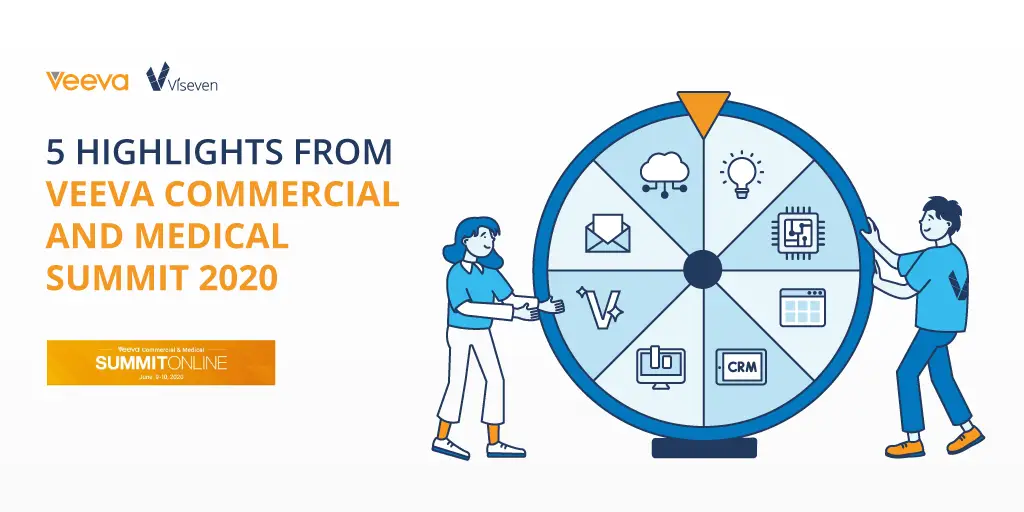
There is nothing special about the fact that a summit hosted by the pharma digital tech giant Veeva is special every time. The North American edition of the Veeva Commercial and Medical Summit 2020 on June 9-10, however, was even more noteworthy. This was not just because of its online format or the very slowly dispelling shadow of COVID-19 lockdowns – but also since so many relevant topics were addressed from a practical point of view. Modular content, AI, digital engagement, customer journeys, omnichannel, data integration – over the past years, these topics were presented at pharma events from a theoretical, somewhat idealistic position. This time around, we are seeing a whole bunch of more practical takes on these. The seed of new tech-inspired visions seems to have come to fruition at last.
Much of the content from the summit (except the roundtable talks) is still available on demand until July 8 on the official event page. Now, this would be too bad of a spoiler for the audience to give away everything we the Viseven team have appreciated about the sessions – and this would take at least 5-7 blog posts like this – so here are just the 5 top highlights for your consideration. Our own experts have more or less unanimously agreed that these will have the most impact on the way digital pharma will run engagement campaign and manage content in the coming years. Before we take the plunge, though, let’s have a very brief overview of the topics that defined the summit and its atmosphere.
Veeva Summit Online: a bird’s eye view
One of the recurrent topics at the summit was (naturally enough) the forced transition to different forms of remote engagement when interacting with HCPs and other stakeholders. With the “new normal” being the buzzword of the year so far, its meaning for pharmaceutical marketing and communications is more or less clear: it is time start that digital multichannel engagement already. With the new accent on remote eDetailing, online events and Approved Emails, enterprises are trying to discover digital engagement that is as personal as the F2F rep calls. An anxious-looking question on whether or not Approved emails can really be considered personal engagement (posed at one of the sessions) was a perfect illustration of that eagerness to stay in contact. Further delving into the issue was done in a session by Crossix on “bridging the gap” between personal and non-personal promotion. As part of the commercial operations flow within the summit, Mark Fleischer, CEO Physicians World, Veeva, delivered a presentation on virtual events organization, including the choice of content and platform.
This, naturally, makes the companies lay more accent on customer engagement strategy – in an effort to avoid simply aggregating digital channels and look at the way it looks from the customer’s perspective. Jennifer Turcotte of Salesforce presented a practical take on building automated customer journeys. On the other end of the spectrum, an entire session (led by Veeva’s Ian Hale) was dedicated to the relevant metrics throughout the content lifecycle. Measuring content performance was an idea that reverberated across several superb presentations, including a take on modular content by Jay McMeekan of Bayer (accidentally, also the highlight #3 in this list, see below). An interesting moment was letting an HCP have a say and describe their perspective on digital engagement – in a Q/A session with hematologist/oncologist Andrew Moore, M.D.
Another big question was data. The current situation requires a more progressive approach to insights – and approaches are not something that is solved in terms of CRM metrics alone. In Jay McMeekan’s words,
Compared with other industries, and pharma in other countries, U.S. pharma has a preponderance of data. But for the most part, it’s not about access to data, it’s more about ho w to use it – and how we plan our engagement, taking into account that information, and not just using it as an afterthought, or justification for an outcome.
An entire section of the event was dedicated to data and intelligence issues, with sessions on Veeva OpenData, Vault API use for data exchange (a topic that fascinates IT departments), as well as a marketer’s and strategist’s take on customer reference data from Biogen. A Veeva Data Cloud Overview (including planning, patient segmentation, commercial analytics, AI, territory design, targeting, and incentive compensation) on Day 1 should be noted, as well.
Of course, this is by no means an exhaustive overview of the summit – with still more on commercial operations, expanding role of the rep, Veeva Nitro, compliance and Approved Notes worth noting for all those who plan to request the summit sessions. Meanwhile, let’s move to the highlights that impressed our specialists and are most likely to produce long-lasting impact.
#1: Best Practices for Approved Email Success (roundtable)
Approved Emails, Veeva’s own service for rep-triggered email messaging, has provided pharma with a way to sidestep the shrinking rep admission rates and keep up the frequency of interactions even before the pandemic. Now its relevance has skyrocketed for Veeva users, who are increasingly interested in, and aware of, the possibilities of this tool. This roundtable featuring Cindy DiNitto, Manager, Commercial SMB Customer Success, consultant Amy LaForgia, and Maria Ruoto, Senior Customer Success Manager (all Veeva professionals) reveals the key points about the service and channel. While Approved Emails present the way to maintain contact and is easily combined with other channels, recent months have seen increased use, not only with the traditional cases but also as a way to invite the HCP to a remote meeting.
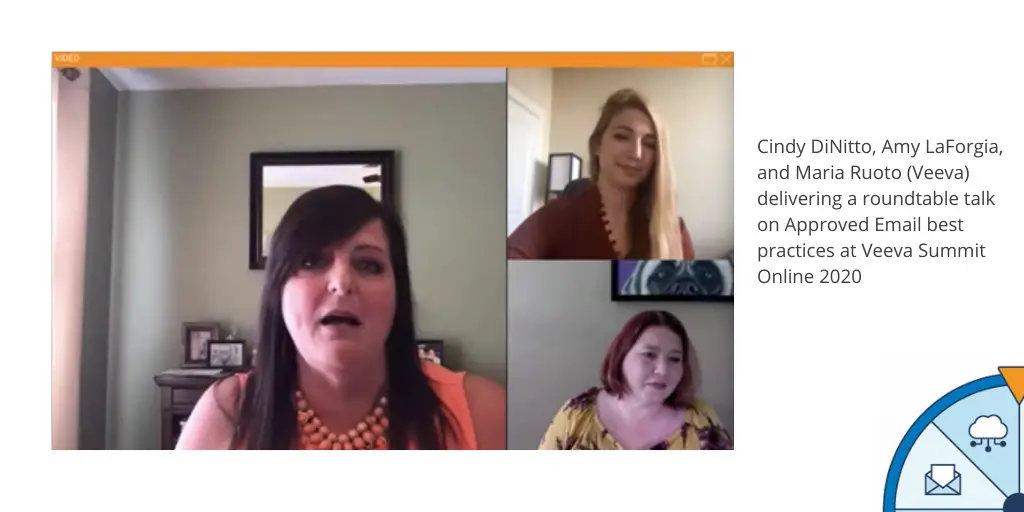
On the other hand, there is the problem of overloading the target audience. Email is a great channel as long as it is not annoyingly frequent. Everything above a certain saturation level turns it into spam, which is a great concern. According to Cindy DiNitto,
It’s not like, “wow, I have all these templates on my iPad, let me just start sending these out”, it’s really having use [case] based training for your field so then you know when is the good time to send that email.
Although (or even because) the system does not impose any hard limits on the amount of emails sent (only a warning message), field reps have to be trained in order to develop a sensitivity as to when sending an Approved Email is appropriate. We can add that this is, in fact, one of the staples of omnichannel thinking – operating in terms of touchpoints – applied to CRM field activity.
Of course, there is also growing interest in the possibilities of personalization, such as free text fields in the templates. That factor draws in its “evil twin”, namely, the need to track and maintain compliance. As mentioned by Maria Ruoto, among other things, a good practice is setting restricted words for free text inputs; however, the truly best practice is providing adequate change management to allow reps feel in control while keeping compliant.
#2: Automating Claims Management with Novo Nordisk (Session and Q/A)
A core claim is an object that represents a piece of information, e.g. “Brand® demonstrates 48% higher efficiency in eliminating long-term effects of [condition]”. Besides the text, this object holds fields for supporting data, obligatory and desirable references, maybe diagrams and additional meta information (from text variants to notes as to how an agency should place this claim on a slide or email they develop). Managing claims is new and promising approach in pharma brand messaging, and was discussed by Bernie Klemmer, Director Marketing Operations at Novo Nordisk in a session and Q/A at the summit. At the time of writing this, his team is in the process of approving the first batch of such claims – the first stage out of four in a process of implementing this innovative mindset.
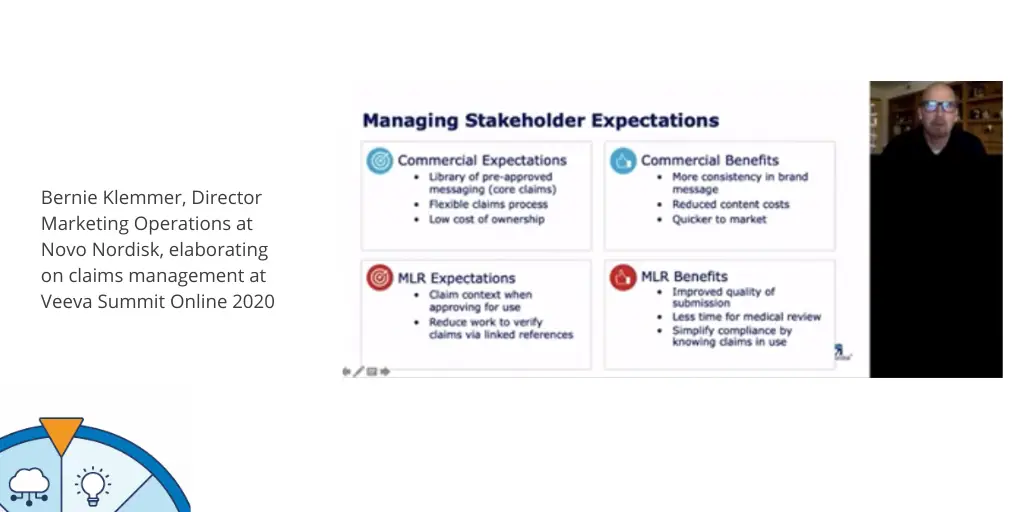
Apart from, obviously, achieving greater consistency and compliance with medical and regulatory, the approach allows to streamline MLR review and make it easier and quicker for agencies to create compliant content. Once the claim document template has been developed with brand team and MLR, it becomes possible to build a library of preapproved claims for such use. Potentially, this allows for more advanced tracking, as well.
At the initial stage of implementation, the pilot stage, Novo Nordisk singled out just one brand and one audience to test the approach and identify possible points that require attention. This involves, among other things, enhancing the claim object with fields to hold data for size and placement, additional text, footnotes, (optional) required or related diagrams, etc. At the second stage, more organizational questions are solved, covering the approval of text variations, expiration procedure for claims, etc. Overall, this approach is very likely to be adopted (with variations) across the industry, since it responds to pharma’s inherent MLR review issues and presents good opportunities to solve them.
#3: Impactful Customer Engagements – Making the Modular Content Connection with Bayer (Session and Q/A)
Modular content is a huge topic in pharma marketing circles right now. A module is essentially the molecular unit of any content – a claim (as in #2 in this review) plus a component or component group (an image, diagram, chart, etc.) that illustrates it or provides context. Such a building block is essentially channel-agnostic and can be featured in an eDetailing presentation, an email, a website, banner, or any other digital content type. This approach is now revolutionizing the way marketers and agencies work with content, with great benefits in terms of cost efficiency and message consistency.
Jay McMeekan, Senior Director, Digital / Multichannel Marketing at Bayer, with his characteristically pragmatic take, starts addressing this issue with data. We have already quoted this session above: the way pharma uses insights is a more pressing issue even than where to obtain them. McMeecan continues along the following lines: how do you know if the content your organization pays for is performing well and resonates with the audience?
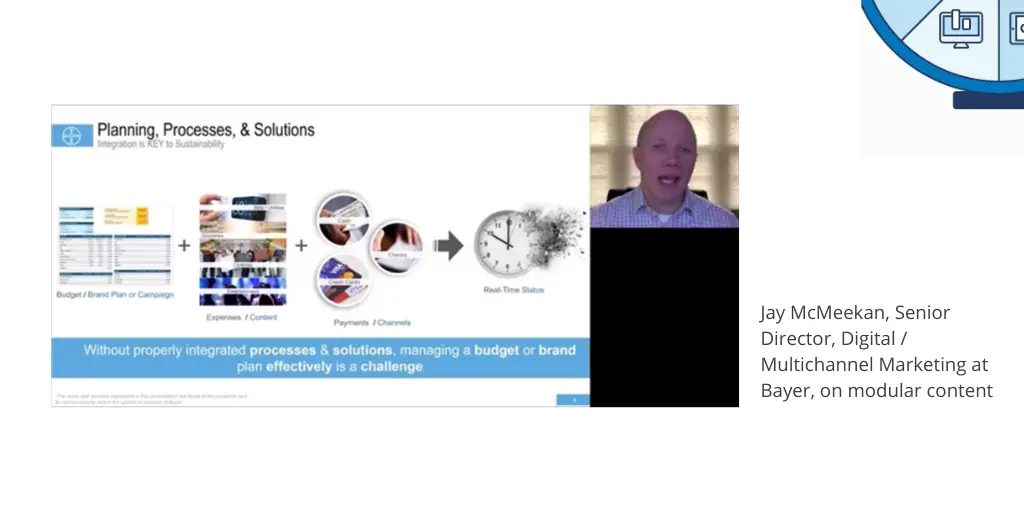
In an analogy with personal finance planning, he proceeds to compare content with expenses and channels with payment methods. If you really want to track the ROI of your content, you have to be able to look beyond single channel and converge data:
You need to begin with a clear measurable goal from the start, or you will never be able to access your performance against your expectations. Especially if you only rely on historical sales data or market share. Waiting until you get your credit card bill to know if you can pay it? I think we can all agree it is not a sustainable financial strategy.
To this end, content modules created must be channel-agnostic and easy to use within different content types. This allows for an additional source of cost efficiency: not only is duplicate agency work eliminated (as predesigned modules are mixed and matched), but the marketer makes sure and continuously tracks that only the content likely to perform well is produced. This assessment of customer engagement in real time is made possible by a clear, hierarchical tagging of modules. Each module comes with a tag composed in a certain predictable was that is unified across the organization. We shall see in the very near future how this approach evolves further on – and it will be interesting to say the least. Our own expertise building modular content strategies for our pharmaceutical customers at Viseven has so far yielded impressive results and the concept is constantly improved.
For more on modular content within this article, see the bonus section below.
#4: Compliant Content to Support the Customer Journey (customer panel with Roche and BMS)
This customer panel featuring Samantha Knott, Global Customer Operations Lead at Roche, Cara Pellegrini, Senior Director, Business Practices Group at Genentech (A Member of the Roche Group), and Dinesh Salvi, Head of Enterprise Veeva and Commercial Systems at Bristol Myers Squibb, and led by Pooja Ojala, Vice President, Commercial Content, Veeva, was an ambitious endeavor. In about 45 minutes, the participants managed to cover their organizations’ approaches and solutions to current issues with commercial content and operations – an impressively wide topic with dozens of possible starting points.
In this case, the starting point chosen was a systematic overview of recent effort, starting with situation and challenges, through solution and outcomes for each of the organizations. The result was a panoramic view, with some of the challenges and aspirations overlapping.
A focus on evolving the operational model is present across the companies. Among the challenges Roche encountered and solved was the huge decentralization, with notable silos, e.g. between commercial and medical – and no dedicated project resource. At the same time, BMS aimed at resolving the challenges of competing priorities and changing marketplace. The two stories coincide in their solution – namely, evolving operating model.
The ways to achieve this were different, but sometimes involved thinking along similar lines. While Roche and Genentech supported this with end-to-end content management (and not just facilitating the MLR), Bristol Myers Squibb, too, made an effort to control and streamline the entire content lifecycle. In this latter case, the modularization (“atomization”) of content was also involved.
#5: Veeva Andi Roadmap (yes, it is AI in your CRM)
Veeva Andi is an AI embedded in Veeva CRM to make next-best action suggestions. As exciting as it is by itself, considering how this can enhance field performance with the ability to process loads of data, there is even more to help pharma users facilitate the workflows. Brian Mahoney, Practice Manager, Digital Field Engagement, Veeva, unveiled several key points about the roadmap for the upcoming Veeva Andi features.
The roadmap was presented along two principal lines – (1) customer touchpoint optimization, and (2) making AI easier. With the power of data and intelligent suggestions, Andi is “poised” to offer additional digital channel models based on the analyzed interactions, as well as suggest what content will engage and perform better. Additionally, such features as weekly top territory insights and targets and models and traits for field users are supposed to be added later on.
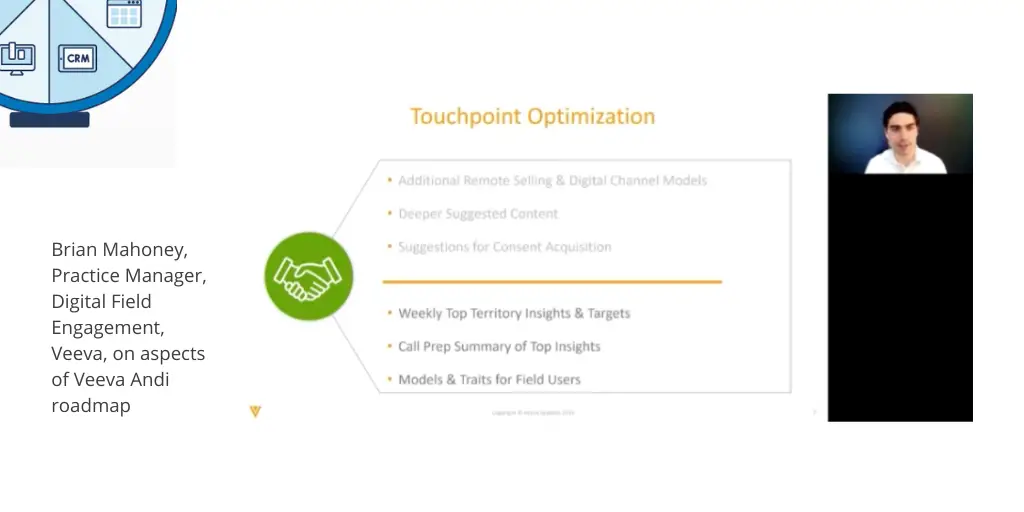
In terms of facilitating AI use, Andi is going to be more than a smart “black box”, with the possibility for the user to choose data sources in Cross Data Source Logic Agent Builder, as well as look inside the process and take a more proactive stance with a suggestions editor.
This is by no means an exhaustive list – more functionalities covering samples and Marketing Cloud integration, to name a few, were also announced.
One interesting observation
When looking at the discourse in the pharma communications and tech circles over the past year or so, an interesting observation can be made. Business rules, workflows, people and skills, tech, content and strategy – all of these factors are now finally being treated in conjunction that they deserve. People have started talking holistic – and taking steps towards a holistic approach, where tech is part of the equation, as is everything else.
At the same time, the very tech used in pharma has become more integrated and integratable – gone are the days when business unit heads had to break everything they had in place into pieces in the name of innovation; today’s technology is plugged into the existing business models. It adapts itself – and slowly, painlessly transforms the organization from deep within.
+ even more on modular content and how to start
Modular content is an example of such a mindset. While enabled by tech solutions, the concept of modularization is a response to needs and challenges at multiple levels.
Content reuse and repurpose possibilities boost cost-efficiency; the approved and redistributed nature of modules circulating across the company’s ecosystem facilitates MLR and improves agency workflows; core claim tracking enables greater data – coming full circle at ROI again. How do we know this? Viseven team has been among the enthusiasts and pioneers of modular approach and has successfully implemented it with a number of global pharma and life sciences customers. For example, a recent case demonstrated speeding up MLR all thanks to a modular content authoring solution integrated with Veeva Suite.
This is where we as a Veeva Technology Partner help start with modular content approach. eWizard content authoring solution not only supports the creation of modules, but is integrated with Veeva, provides the possibility to dive into deep editing directly from Vault PromoMats, serves as a connector between Veeva and systems like Salesforce Marketing Cloud.
You can see how easily all of this is done in practice in a set of videos showing the functionality and workflows – the shortest possible guide into starting out with modular content. Additionally, have a look at what eWizard platform can offer you to streamline Approved Email production and approval in Veeva. Select one of the sections below to access the overviews.
The post 5 highlights from Veeva Commercial and Medical Summit Online 2020 appeared first on Viseven.